How Long Are Leftover Ribs Good for
You can safely store leftover ribs in your refrigerator for 3-4 days when properly wrapped in airtight containers or aluminum foil, maintaining a temperature at or below 40°F. For longer storage, freeze your ribs at 0°F or below, where they'll maintain best quality for up to 4 months, though they remain safe indefinitely when frozen. Always refrigerate your ribs within 2 hours of cooking (or 1 hour if it's above 90°F), and watch for signs of spoilage like off-putting odors, slimy texture, or discoloration. While these basic guidelines guarantee food safety, proper storage and reheating techniques can make a significant difference in preserving your ribs' flavor and texture.
This post may contain affiliate links. If you make a purchase through these links, I may earn a commission at no additional cost to you. Additionally, portions of this post may be generated using artificial intelligence (AI) technology. While we strive for accuracy, please be aware that AI-generated content may not always be perfect and should be fact-checked when necessary.
The Spatula Scoops
- Properly stored cooked ribs last 3-4 days in the refrigerator when kept at or below 40°F.
- Leftover ribs can be safely frozen for up to 6 months, with best quality maintained for 3-4 months.
- Refrigerate leftover ribs within 2 hours of cooling, or within 1 hour if temperatures exceed 90°F.
- Check for spoilage signs like off-putting odors, slimy texture, grayish-brown color, or visible mold.
- Use airtight containers or double-wrap ribs in plastic wrap and aluminum foil for optimal storage.
Safe Storage Time Guidelines
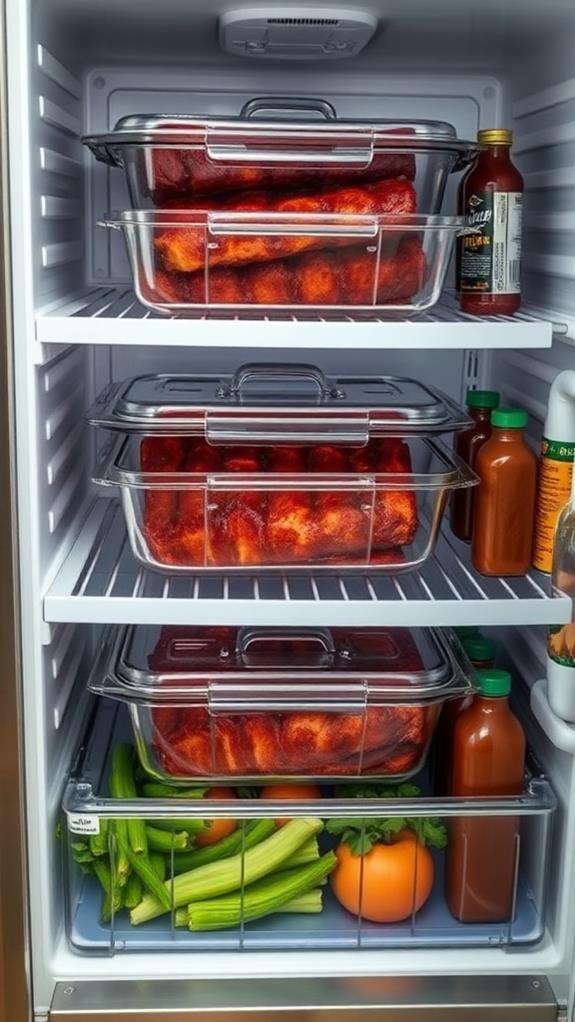
When properly stored, cooked ribs can last 3-4 days in the refrigerator or up to 6 months in the freezer. You'll need to refrigerate your leftover ribs within two hours of cooking (or one hour if the temperature is above 90°F) to maintain food safety standards and prevent bacterial growth.
For refrigerator storage, you should wrap your ribs tightly in plastic wrap or aluminum foil, or place them in an airtight container. If you're planning to freeze your ribs, double-wrap them in heavy-duty aluminum foil or freezer paper, then place them in a freezer-safe zip-top bag to prevent freezer burn.
You'll know your refrigerated ribs have gone bad if you notice any off-putting odors, slimy texture, or discoloration. For frozen ribs, check for signs of freezer burn, which appears as grayish-brown leathery spots. While freezer burn won't make you sick, it can affect the taste and texture of your ribs. Remember to label your storage containers with the date you're putting them away, so you can track how long they've been stored.
Proper Refrigeration Methods
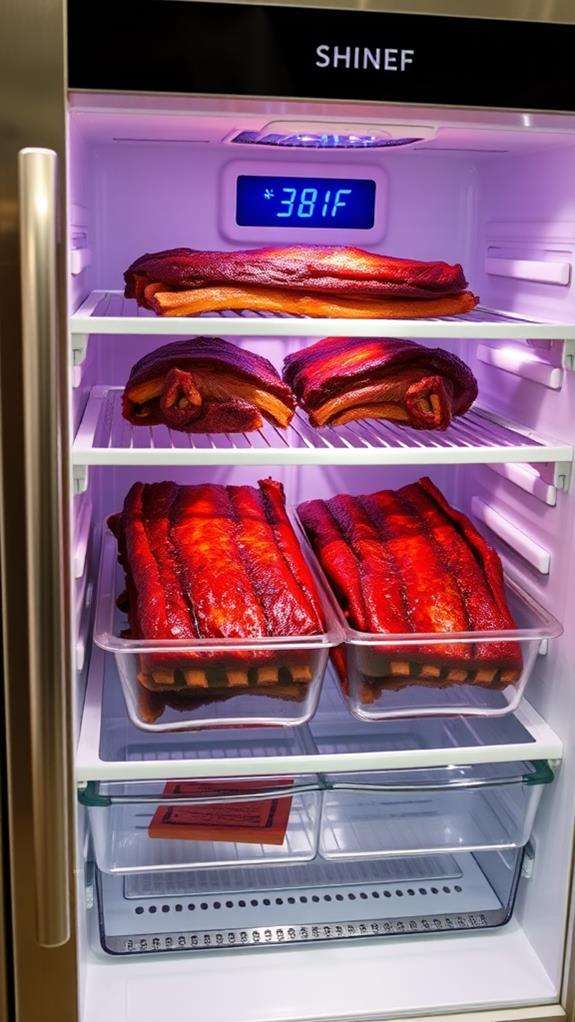
To keep your leftover ribs fresh for the maximum time possible, you'll need to store them in airtight, food-grade containers or wrap them tightly in heavy-duty aluminum foil, making sure there's minimal air trapped inside. Your refrigerator's temperature should be set between 36-38°F (2-3°C), which you can verify using an inexpensive refrigerator thermometer placed in the center shelf. When storing the ribs, place them on a middle shelf with enough space around the container to allow cold air to circulate freely, avoiding overcrowding that could create warm spots and accelerate spoilage.
Storage Container Selection Tips
Selecting the right storage container makes a significant difference in how long your leftover ribs will stay fresh. You'll want to choose airtight containers made from food-grade materials, such as glass, BPA-free plastic, or stainless steel, which prevent both air exposure and potential chemical leaching.
For ideal freshness, you should select containers that are just large enough to hold your ribs without too much extra space, as excess air can accelerate spoilage. If you're using plastic wrap or aluminum foil, make sure to create a tight seal by wrapping the ribs at least twice, eliminating any air pockets. Resealable plastic bags work well too, but you'll need to squeeze out as much air as possible before sealing.
Consider using containers with compartments if you're storing ribs with sauce separately, which helps prevent the meat from becoming soggy. Clear containers are particularly useful as they allow you to quickly identify contents without opening them. If you're planning to freeze your ribs, opt for freezer-safe containers with tight-fitting lids that can withstand temperature fluctuations without cracking or warping.
Ideal Temperature Settings
Proper temperature control determines whether your carefully stored ribs will stay fresh or spoil prematurely. Your refrigerator's temperature should consistently remain at or below 40°F (4.4°C), which is the safe zone for preventing bacterial growth. It is crucial to check your fridge's temperature regularly using an appliance thermometer, as the built-in dial settings aren't always accurate.
When you're storing your leftover ribs, place them in the main compartment of your refrigerator rather than the door, where temperatures can fluctuate each time you open it. The back of the middle shelf typically maintains the most stable temperature. If you've got multiple containers of ribs, don't stack them too closely together, as this can create warm spots where bacteria might thrive.
For ideal food safety, you'll want to get your ribs into the refrigerator within two hours of cooking (or one hour if the ambient temperature is above 90°F). Don't put hot ribs directly into the fridge; let them cool for 15-20 minutes first, but no longer. This approach prevents your refrigerator from working too hard while still maintaining food safety standards.
Proper Air Circulation Methods
Effective air circulation plays an essential role in keeping your leftover ribs fresh and safe to eat. To guarantee proper airflow in your refrigerator, you'll need to store your ribs in shallow, airtight containers that allow cold air to move freely around them. Don't stack multiple containers on top of each other, as this can create warm spots and promote bacterial growth.
When storing your leftover ribs, place them on middle shelves where air circulation is ideal, rather than in the back corners or door compartments. You should wrap them loosely in aluminum foil or plastic wrap before placing them in containers, making sure there's a small amount of space between the meat and the container's lid. If you're using plastic storage bags, remove as much air as possible before sealing.
Keep your refrigerator's vents unobstructed by avoiding overcrowding, and don't place items directly in front of air circulation points. It's also important to maintain your refrigerator's temperature at or below 40°F (4°C), as proper air circulation works hand in hand with consistent temperature control to preserve your leftover ribs effectively.
Signs of Spoilage
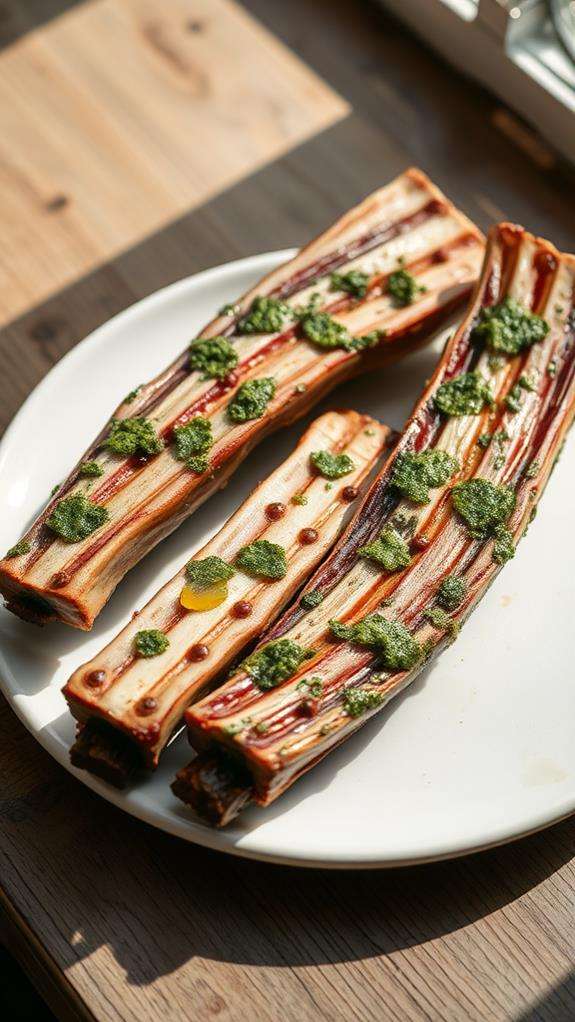
Your leftover ribs' freshness depends on recognizing essential warning signs of spoilage. When examining your ribs, you'll want to check for several telltale indicators that can signal they're no longer safe to eat. Cooked ribs, like chicken, should not be left out at room temperature for extended periods, as improper storage can lead to serious health risks due to foodborne illness concerns.
First, look for any changes in color, particularly if the meat has turned grayish-brown or has developed greenish spots. You'll also want to check for any slimy texture or film on the surface, which often indicates bacterial growth. If you notice any fuzzy spots or mold growth, whether white, blue, or green, discard the ribs immediately.
The smell test is essential – if you detect any sour, rancid, or unusual odors that weren't present when the ribs were fresh, it's time to throw them out. Don't rely on taste testing, as this could expose you to harmful bacteria. You might also notice that the fat has developed a yellow tinge or that the meat feels tacky to the touch. When examining the sauce or marinade, watch for any separation, bubbling, or fermentation that wasn't present before. If you're storing ribs with bones, pay special attention to the areas around the bones, as these spots tend to show spoilage first.
Freezing Leftover Ribs
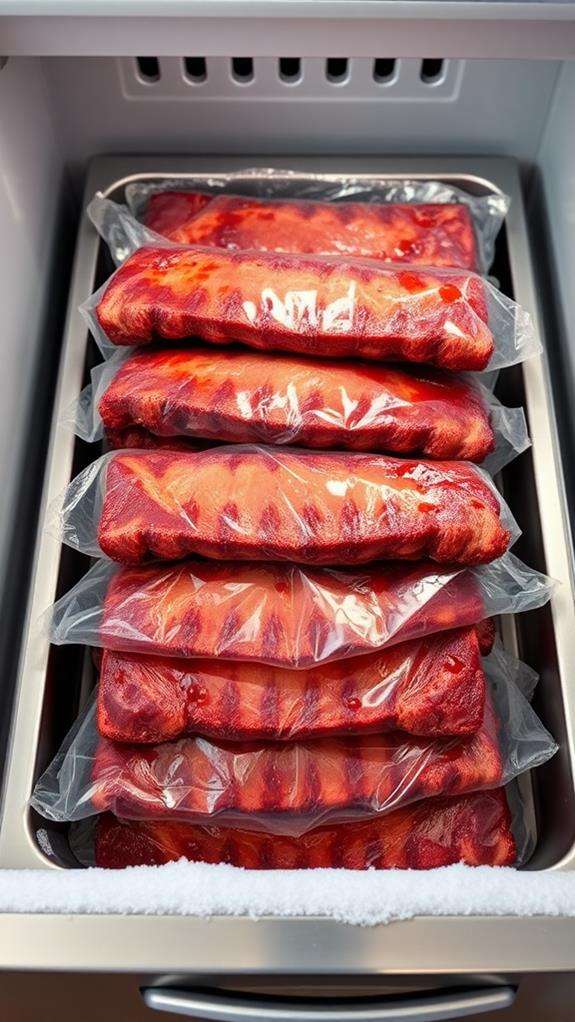
To keep your leftover ribs fresh for months, you'll need to properly wrap them in freezer-safe packaging, like heavy-duty aluminum foil or vacuum-sealed bags, making sure to remove as much air as possible to prevent freezer burn. When stored correctly at 0°F (-18°C) or below, cooked ribs can maintain their quality for up to 4-6 months in the freezer, though they'll remain safe to eat indefinitely at this temperature. For the best results, label your wrapped ribs with the date of freezing, and consider dividing them into smaller portions that you can thaw individually when you're ready to enjoy them again.
Proper Freezer Storage Steps
Proper freezing techniques can greatly extend the life of leftover ribs for up to 6 months. To start the freezing process, you'll need to let your ribs cool completely to room temperature, which typically takes about 30 minutes. Once cooled, wrap each portion individually in heavy-duty aluminum foil, making sure there aren't any tears or holes where air can enter.
For an extra layer of protection, you'll want to place the wrapped ribs in freezer-safe plastic bags or airtight containers. Before sealing, press out as much air as possible to prevent freezer burn. If you're using plastic bags, consider using the water displacement method: submerge the nearly-sealed bag in water up to the zip line, letting the water pressure push out remaining air before completely sealing. Don't forget to label each package with the date and contents using a permanent marker. When storing in your freezer, place the ribs toward the back where temperatures remain most consistent. For best quality, arrange them in a single layer until frozen solid, after which you can stack them to save space.
Recommended Freezing Time Limits
Most leftover ribs will maintain their best quality in the freezer for 3 to 4 months, though they'll remain safe to eat for up to 6 months when properly stored. You'll notice that after the 4-month mark, your ribs may start developing freezer burn, which can affect their taste and texture but won't make them unsafe to consume.
For beef ribs, you can typically expect them to maintain prime flavor for up to 4 months, while pork ribs might start showing slight quality changes after 3 months. If you've smoked or seasoned your ribs heavily, you'll want to stay closer to the 3-month mark, as intense flavors can become altered during extended freezing periods. When storing pre-cooked ribs from restaurants, reduce these timeframes by about a month since you can't be certain about their initial freshness.
To track storage time effectively, you should always label your frozen ribs with the date you've stored them. If you notice ice crystals forming inside the packaging or discoloration before the recommended timeframe, it's often an indication that your storage method needs improvement or your freezer temperature isn't consistent enough.
Best Packaging Methods
Successful freezer storage depends heavily on your packaging technique. To maintain your leftover ribs' quality, you'll need to wrap them tightly in multiple layers using the right materials and methods.
Start by wrapping your ribs in a layer of plastic wrap, pressing out as much air as possible while ensuring every surface is covered. Next, add a layer of heavy-duty aluminum foil, which provides additional protection against freezer burn and helps prevent moisture loss. If you're planning to store the ribs for more than two months, consider using a vacuum sealer for ideal results.
Don't forget to label your packages with the contents and date using a permanent marker. You'll want to write both the packaging date and "best by" date, which should be within 4-6 months for ideal quality. If you're freezing multiple portions, wrap them separately rather than as one large package. This way, you can thaw only what you need without compromising the remaining portions. For extra protection, place your wrapped ribs in a freezer-safe zip-top bag, squeezing out excess air before sealing. Store them in the coldest part of your freezer, typically toward the back.
Reheating Techniques

Bringing leftover ribs back up to temperature requires careful attention to prevent them from drying out. You'll want to choose a reheating method that maintains moisture while ensuring food safety standards are met.
| Method | Temperature | Time |
|---|---|---|
| Oven | 250°F | 20-30 min |
| Microwave | 50% power | 2-3 min |
| Grill | 225-250°F | 15-20 min |
| Sous Vide | 165°F | 45 min |
| Air Fryer | 350°F | 5-7 min |
For the best results, you'll want to wrap your ribs in aluminum foil before reheating them in the oven, adding a splash of apple juice or broth to create steam. If you're using a microwave, place a damp paper towel over the ribs and heat them in short intervals. The grill method works well when you're aiming to restore that smoky flavor, but you'll need to watch them carefully to prevent burning. Sous vide offers precise temperature control but takes longer, while the air fryer provides quick results with a crispy exterior. Remember to check that your reheated ribs reach an internal temperature of 165°F for food safety.
Food Safety Best Practices
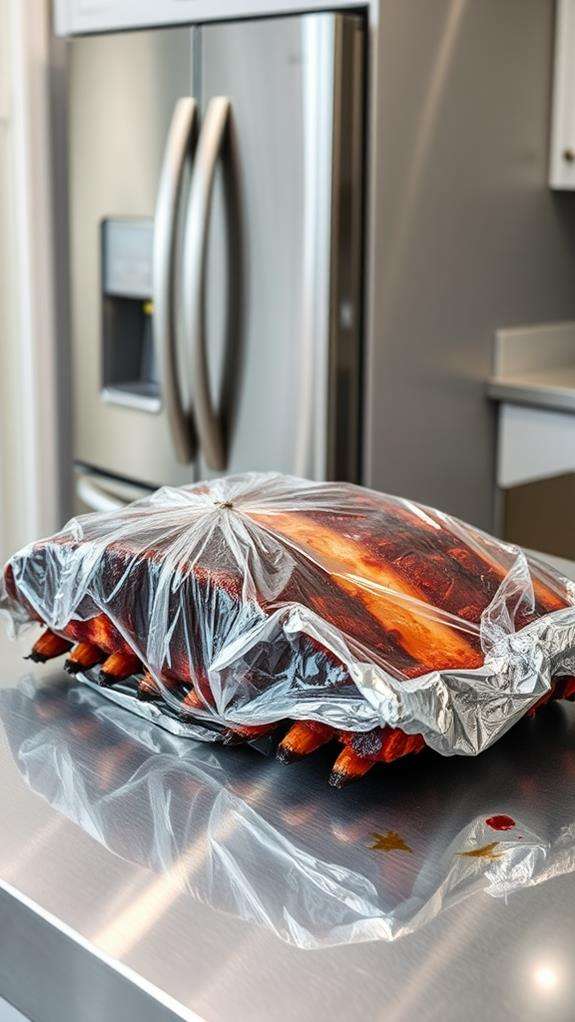
Proper food handling techniques are essential when storing and reheating leftover ribs. When you're dealing with leftover meat, you'll need to follow specific temperature guidelines and storage protocols to prevent foodborne illness.
As soon as your ribs have cooled to room temperature, you should transfer them to an airtight container or wrap them tightly in aluminum foil or plastic wrap. Don't let them sit out for more than two hours, as bacteria multiply rapidly between 40°F and 140°F, known as the "danger zone." Your refrigerator should be set at 40°F or below to guarantee proper food safety.
Always wash your hands thoroughly before handling leftover ribs, and use clean utensils and cutting boards to prevent cross-contamination. If you're planning to store portions separately, use individual containers or bags to minimize exposure to air and bacteria. When reheating, confirm the internal temperature reaches 165°F throughout the meat, using a food thermometer for accuracy. If you notice any unusual odors, discoloration, or mold growth, it's best to discard the ribs immediately. Remember, when in doubt, throw it out.
Frequently Asked Questions
Can Leftover Ribs Be Served Cold, or Must They Always Be Reheated?
You can enjoy leftover ribs either cold or reheated – it's entirely your choice. While cold ribs offer a firm, chewy texture that some people love, reheating brings back that warm, tender quality you experienced when they were fresh. If you're serving them cold, they're perfect for picnics or quick lunches. However, if you prefer them warm, just reheat them slowly in the oven at 250°F until they reach your desired temperature.
Do Different Types of Rib Marinades Affect How Long They Stay Fresh?
Different marinades can indeed affect your ribs' shelf life. Acidic marinades, like those with vinegar or citrus, can slightly extend freshness by inhibiting bacterial growth. However, marinades with sugar or dairy may reduce shelf life as they provide more nutrients for bacteria to thrive. You'll want to store any marinated ribs in an airtight container, regardless of the marinade type, and consume them within 3-4 days when refrigerated properly.
Should You Remove Meat From Bones Before Storing Leftover Ribs?
You'll want to keep the meat on the bones when storing leftover ribs, as this helps maintain moisture, flavor, and texture. The bones act as natural insulators, preventing the meat from drying out too quickly in your refrigerator. Additionally, the connective tissues around the bones continue to provide flavor even after cooking. When you're ready to reheat, having the meat on the bone also helps guarantee more even warming.
Can You Store Leftover Ribs With Other Cooked Meats in Containers?
You shouldn't store leftover ribs with other cooked meats in the same container, as this can lead to cross-contamination and mixed flavors. Each type of meat has different storage needs and spoilage rates. Instead, you'll want to store your ribs separately in an airtight container or wrapped tightly in foil. This practice helps maintain the ribs' distinct flavors and guarantees proper food safety standards.
Do Smoked Ribs Have a Different Shelf Life Than Grilled Ribs?
Picture two plates of ribs – one smoky, one grilled. While both cooking methods create delicious results, they don't greatly impact storage life. You'll want to treat both types the same way, storing them in your fridge for 3-4 days. The smoking process does add preservative compounds, but it's minimal in modern quick-smoking methods. For both types, you'll notice the best flavor and texture within the first two days.





